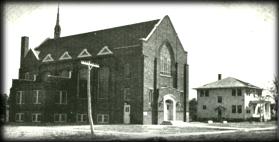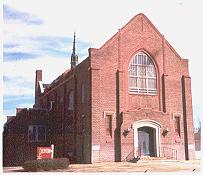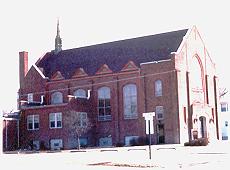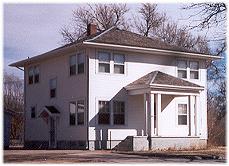 The First Presbyterian Church, WaKeeney, Kansas, dates back to it's organization at the home of A. L. Cook,
March 31, 1878, being completed April 17, 1878.
The First Presbyterian Church, WaKeeney, Kansas, dates back to it's organization at the home of A. L. Cook,
March 31, 1878, being completed April 17, 1878. Rev. Jas. Mitchell of Hays City, Kansas, having been appointed by the Presbytery of Solomon to organize a Presbyterian Church at WaKeeney, Kansas, if the way be found clear, called a meeting at three (3) o'clock P. M., March 31, 1878, at the house of Bro. A. L. Cook.
The meeting having been called to order Rev. Mitchell was elected chairman.. On motion A. A. Hamilton was elected Secretary. The chairman then read letters from Rev. J. K. Wilson. Moved by A. L.. Cook-seconded by B. W. Thom that we proceed to take the initiatory steps toward organizing a Presbyterian Church. Motion to amend made by G. S. Gavet that a ballot be taken to ascertain what form of church government be preferred by the majority. The secretary was directed to count the ballot and found it to stand as follows: Presbyterian (7) seven, Methodist (3) three, Friends (2) two, Congregational (2) two, American Reformation (1) one, Union (1) one. The vote was then put on original motion and carried. Thirteen persons signing said petition as indicated on that paper now among Presbyterial records-as follows: B. W. Thom, Mrs. Thom-A. L. Cook, Mrs. Cook-A. A. Hamilton-H. H. Monroe-Fred Monroe-Jas. Johnston-Mr. Rowley-Mr. and Mrs. Penrose -James Green. Motion was made and seconded to ask Presbytery to send Rev. J. K. Wilson of Cedarville, New Jersey, to this place as a minister of the Gospel if the way seem clear. Carried. Meeting opened and closed with Prayer.-H. H. Hamilton, Sec.
A meeting of the Session was held immediately following close of service at which the letters of H. H. Hamilton, Mrs. H. H. Monroe, Fred Monroe, A. L. Cook and Mary J. Cook, his wife, were received and the parties themselves received into fellowship. Brother Thom and wife, Bro. Green and wife, and Bro. Johnson all expressed their intentions to present their letters as soon as they could be received from the East.
Rev. Mitchell appointed Mr. Hamilton . Clerk. Applications were formally made to Presbytery to sustain application made to H. M. Board for the support of Rev. J. K. Wilson. The meeting closed with Prayer.-H. H. Hamilton, Clerk.
 Church services were first held in the Warren and Keeney building on the west side of Franklin St. (now .Main
Street,). The railroad built a stone depot and the frame depot was bought by the church and moved in December,
1879, to lots on the corner of 8th and -Russell where, Judge Long later built his home. When nearly there with the
building a table broke and snapping around it struck and killed a small boy; A
bell was brought in from a farm east of town and used by the church. This frame depot building was used for a
church by Presbyterians for about nine years used later by other denominations.
Church services were first held in the Warren and Keeney building on the west side of Franklin St. (now .Main
Street,). The railroad built a stone depot and the frame depot was bought by the church and moved in December,
1879, to lots on the corner of 8th and -Russell where, Judge Long later built his home. When nearly there with the
building a table broke and snapping around it struck and killed a small boy; A
bell was brought in from a farm east of town and used by the church. This frame depot building was used for a
church by Presbyterians for about nine years used later by other denominations. About the winter of 1880-1881 they passed through a long period of bitter cold. In those days tramps traveled this country in large numbers. One bitter cold night E. W. Blair noted a light in the church. Going and looking in at the window he saw a number of men around the stove in which they had built a fire. Getting other neighbors to go along he went in and talked to the tramps who had sought shelter. Cautioning them to be careful of the building and the fire, they were left in the church and occupied it nearly a week; the men of the town keeping a watch on them. They rustled their own coal from the railroad and brought it to the church. The frame depot church housed nearly 50 tramps that winter. The church performed many deeds of charity for many came who did not have homes.
According to a report written an July 14, 1888, by James Kelly who was then chairman of the building committee for the erection of a new building Mr. Kelly says, "About a year ago the Presbyterians of WaKeeney concluded that the time had come when a new church building was desirable and a subscription paper was started for that purpose, but not until October was it definitely decided to build, at which time a building committee was selected by the congregation with full power to act in the matter."
 Present site of the church purchased Nov. 4, 1887, from Jas. M. Miller and Jos. S. Werlick. Subscription list
for this building shows such contributors as: James Kelly (great grandfather of Frankie Wonner), R. C. Wilson,
(Mrs. Jane Heckman's father), A. H. Blair (Stella Larabee~s father), James B. Walker (grandfather of the F. B. and W.
R. Walker children), Marshall and Ufford (Marshall, father of Roy Marshall), Leonard Schmitt (grandfather of
Schuyler Gibson), Joshua Groft (father of Anna DeWitt and Mary Groft), Geo. Baker (father of Walter and C. H.
Baker), A. B. Jones (husband of the late Clara Jones) and many others with no living relatives here now.
Present site of the church purchased Nov. 4, 1887, from Jas. M. Miller and Jos. S. Werlick. Subscription list
for this building shows such contributors as: James Kelly (great grandfather of Frankie Wonner), R. C. Wilson,
(Mrs. Jane Heckman's father), A. H. Blair (Stella Larabee~s father), James B. Walker (grandfather of the F. B. and W.
R. Walker children), Marshall and Ufford (Marshall, father of Roy Marshall), Leonard Schmitt (grandfather of
Schuyler Gibson), Joshua Groft (father of Anna DeWitt and Mary Groft), Geo. Baker (father of Walter and C. H.
Baker), A. B. Jones (husband of the late Clara Jones) and many others with no living relatives here now. After some delays the plans and specifications were accepted and work on the basement and foundation, was commenced. The contract for the building was let in January, 1888, and the building was dedicated in July, 1888. The cost of the original building was $4,260.11. In the erection of this building The First Presbyterian Church of WaKeeney received a loan on June 12, 1888, from the Board of Church Erection Fund of the General Assembly of the Presbyterian Church in the U. S. of America. This mortgage of 850.00 was satisfied on May 16, 1925, by payment of $850.00 to them by the insurance company following the destruction of the original building by fire. All other debts on the original building were paid at time of the dedication but the small amount of $171.69 carried by the board of trustees personally and was later paid back by friends of the church. The building when completed was very attractive in appearance and design and served the congregation many years.
In 1921 the members of the congregation felt the need of additional room for their growing primary department of the Sunday School and for the congregational needs on special occasions. In examining the old building they found that the architect had so designed it that an addition could be built on either the north or south side without destroying the value of the assembly room or the appearance of the original building. They decided to erect an addition 28 by 30 feet on the south side, including a basement under a part of the old structure and the new portion. The addition was completed by early the next year and was found to be a source of great convenience and satisfaction to the needs of the primary department of the Sunday School.
Subscribing for this addition to the church some of the contributors who have passed on: A. P. Hinshaw, J. H. Niesley, F. B. Walker, C. L. Hardman, J. W. Bingham, O. L. Lucas, J. J. Keraus, W. W. Parks, L. C. Gleason, Walter Swiggett, S. A. Shriner, H. F. Kline, Pete DeBoer, W. R. Walker, Ida Pierson, Mrs. W. Mattingly, F. H. Burnham and many others.
In 1923 the church congregation learned that The First Presbyterian Church at Dodge City, Kansas, was about to erect a new building and was offering an excellent pipe organ for sale, an organ which they had used in their old building. A subscription list for funds was started and in a very short time enough money had been raised to defray all the expenses of buying the organ and building an addition to accomodate it. A small addition was made on the old building and the organ was dedicated on May 28, 1923. The organ was found to be a source of much satisfaction and convenience and a great addition to the musical advantage of the church congregation.
The church organization continued to progress and in 1924 decided that the pastors who should serve them hereafter should have a better manse to live in, than the old one which had served them since 1904. A subscription list was circulated and the necessary funds were soon available for the new building. The old manse property was sold and the proceeds added to the fund. Mrs. A. B. Jones donated a twentyfive foot building lot adjoining the church property on the south and the new manse was erected thereon. It is a two story building 32 by 32 feet with full basement and modern throughout. A garage was also built, the total cost of both buildings being a little over $7,700.00
 While the manse was in the course of construction what appeared to be the greatest disaster which could
have befallen the congregation happened on March 25, 1925. Before daybreak the fire alarm sounded. The Church
was afire and the members of the WaKeeney City Fire Department worked heroically in their efforts to extinguish the
flames and to save the new manse building and they were successful in their efforts as there was no wind. The new
property was not damaged although only a few feet away from the south wing of the church. The fire caught on the
inside from causes unknown; not any of the Church was saved for any use and there was very little salvage. The
greatest loss in the way of contents was the pipe organ. The old building with the pipe organ was insured for
$7,700.
While the manse was in the course of construction what appeared to be the greatest disaster which could
have befallen the congregation happened on March 25, 1925. Before daybreak the fire alarm sounded. The Church
was afire and the members of the WaKeeney City Fire Department worked heroically in their efforts to extinguish the
flames and to save the new manse building and they were successful in their efforts as there was no wind. The new
property was not damaged although only a few feet away from the south wing of the church. The fire caught on the
inside from causes unknown; not any of the Church was saved for any use and there was very little salvage. The
greatest loss in the way of contents was the pipe organ. The old building with the pipe organ was insured for
$7,700. This little story goes along with the fire. As related by Mrs. McCormick: "There were four teen-age boys, Jim Hutchison, Harold and Robert Heckman and Robert McCormick, who had rigged up what they called a fire engine from an old carpet sweeper because of a series of fires about every three weeks that spring. Thy had informed their folks that if there should be another fire they wanted to be called to make use of their machine. Not one of the fathers thought it advisable it seems so these boys were quite put out when they found out what had happened to their own church."
Rev. L. H. McCormick was then pastor of the church. He immediately called together the members of the official board and while the embers were yet smoldering, the board unanimously decided to "carry on" and voted to proceed at once on plans and arrangement for a new building. Their sentiment was that they should build for the future as well as the present and that a larger and better building be erected. The following day several of the church men and Rev. McCormick took a trip to see several new churches in the area.
Many plans were studied; soon a plan was accepted and the contract let. On April 18, 1926, the corner stone for the new church was laid; the corner stone of the original building occupying one of the front corners of the new building, a new stone being laid on the other. In the contents of the box placed in the new corner stone was a picture of the old building as it last appeared, a Bible used by Mrs. James Walker (one of the pioneer members of the church), a brief history of the church and some other articles.
Rev. McCormick was constantly on the elert to see that the blue prints were being followed. Mrs. McCormick said, "One Saturday afternoon he hurried over but the carpenter was ahead of him and had already started to lay the pulpit platform. There had been no careful selection of the flooring so he had it all torn out and he stayed there until it was all .finished, selecting each board and seeing that it went in properly to assure a floor pleasing to the eye."
The day of the dedication the weather was perfect; since there was no frost it was exceedingly warm. Surrounding the lovely new church were the green lawns and beautiful flower gardens that Rev. McCormick had so lovingly tendered to match the beauty of this new place of worship.